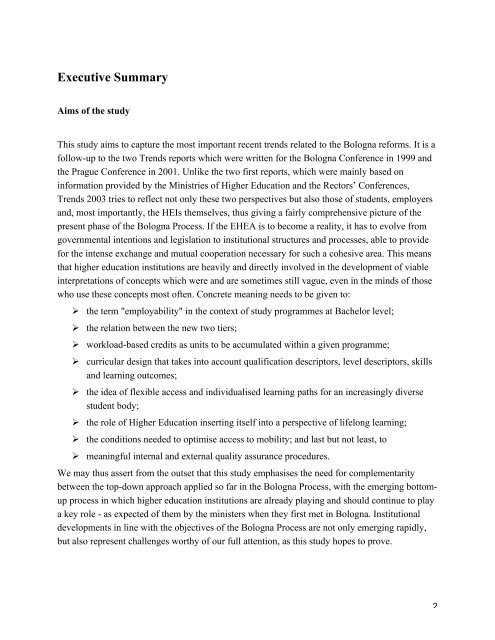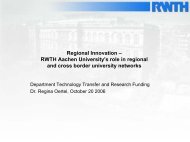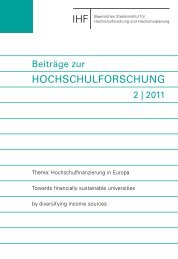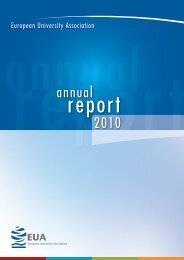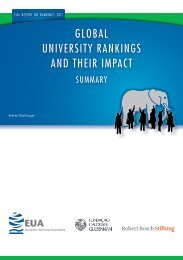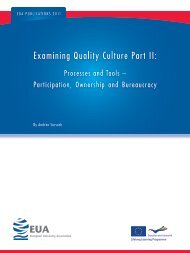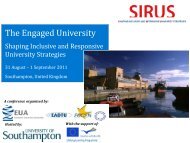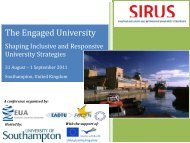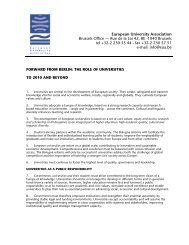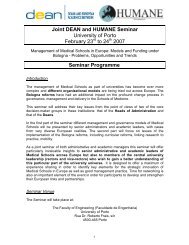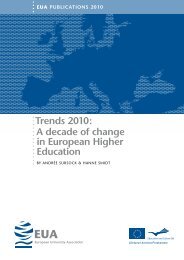Trends 2003 Progress towards the European Higher Education Area ...
Trends 2003 Progress towards the European Higher Education Area ...
Trends 2003 Progress towards the European Higher Education Area ...
Create successful ePaper yourself
Turn your PDF publications into a flip-book with our unique Google optimized e-Paper software.
Executive Summary<br />
Aims of <strong>the</strong> study<br />
This study aims to capture <strong>the</strong> most important recent trends related to <strong>the</strong> Bologna reforms. It is a<br />
follow-up to <strong>the</strong> two <strong>Trends</strong> reports which were written for <strong>the</strong> Bologna Conference in 1999 and<br />
<strong>the</strong> Prague Conference in 2001. Unlike <strong>the</strong> two first reports, which were mainly based on<br />
information provided by <strong>the</strong> Ministries of <strong>Higher</strong> <strong>Education</strong> and <strong>the</strong> Rectors’ Conferences,<br />
<strong>Trends</strong> <strong>2003</strong> tries to reflect not only <strong>the</strong>se two perspectives but also those of students, employers<br />
and, most importantly, <strong>the</strong> HEIs <strong>the</strong>mselves, thus giving a fairly comprehensive picture of <strong>the</strong><br />
present phase of <strong>the</strong> Bologna Process. If <strong>the</strong> EHEA is to become a reality, it has to evolve from<br />
governmental intentions and legislation to institutional structures and processes, able to provide<br />
for <strong>the</strong> intense exchange and mutual cooperation necessary for such a cohesive area. This means<br />
that higher education institutions are heavily and directly involved in <strong>the</strong> development of viable<br />
interpretations of concepts which were and are sometimes still vague, even in <strong>the</strong> minds of those<br />
who use <strong>the</strong>se concepts most often. Concrete meaning needs to be given to:<br />
ÿ <strong>the</strong> term "employability" in <strong>the</strong> context of study programmes at Bachelor level;<br />
ÿ <strong>the</strong> relation between <strong>the</strong> new two tiers;<br />
ÿ workload-based credits as units to be accumulated within a given programme;<br />
ÿ curricular design that takes into account qualification descriptors, level descriptors, skills<br />
and learning outcomes;<br />
ÿ <strong>the</strong> idea of flexible access and individualised learning paths for an increasingly diverse<br />
student body;<br />
ÿ <strong>the</strong> role of <strong>Higher</strong> <strong>Education</strong> inserting itself into a perspective of lifelong learning;<br />
ÿ <strong>the</strong> conditions needed to optimise access to mobility; and last but not least, to<br />
ÿ meaningful internal and external quality assurance procedures.<br />
We may thus assert from <strong>the</strong> outset that this study emphasises <strong>the</strong> need for complementarity<br />
between <strong>the</strong> top-down approach applied so far in <strong>the</strong> Bologna Process, with <strong>the</strong> emerging bottomup<br />
process in which higher education institutions are already playing and should continue to play<br />
a key role - as expected of <strong>the</strong>m by <strong>the</strong> ministers when <strong>the</strong>y first met in Bologna. Institutional<br />
developments in line with <strong>the</strong> objectives of <strong>the</strong> Bologna Process are not only emerging rapidly,<br />
but also represent challenges worthy of our full attention, as this study hopes to prove.<br />
2


